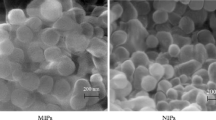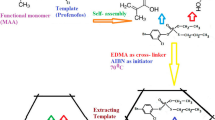Abstract
A modified quick, easy, cheap, effective, rugged, and safe (QuEChERS) sample preparation method coupled with gas chromatography–tandem mass spectrometry has been developed for the simultaneous analysis of amide/dinitroaniline/substituted urea herbicides in bivalve shellfish samples. A molecularly imprinted polymer (MIP) synthesized through bulk polymerization exhibited strong group–selective interactions with pigments, including β-carotene, chlorophyll A, and fucoxanthin, in bivalve shellfish extracts. Afterward, a modified QuEChERS method based on MIPs and primary and secondary amines was established to effectively remove matrix components in bivalve shellfish samples. Under the optimal conditions, good linearities were obtained in all of the analytes with R2 larger than 0.9995. Limits of quantification were in the range of 0.03–8.88 μg kg−1, respectively. The recoveries of all of the herbicides spiked at three concentrations of 10, 25, and 50 μg kg−1 in blank bivalve shellfish samples ranged from 81 to 109% with intra-day and inter-day relative standard deviations less than 8%, respectively. Results demonstrated that the proposed QuEChERS method coupled with GC–MS/MS was applied successfully to simultaneously determine 26 amide/dinitroaniline/substituted urea herbicides in bivalve shellfish.




Similar content being viewed by others
References
Kumar A, Shalini Sharma G, Naushad M, Kumar A, Kalia S, Guo C, Mola GT (2017) Facile hetero-assembly of superparamagnetic Fe3O4/BiVO4 stacked on biochar for solar photo-degradation of methyl paraben and pesticide removal from soil. J Photochem Photobio A-Chem 337:118–131
Benbrook CM (2016) Trends in glyphosate herbicide use in the United States and globally. Environ Sci Eur 28:3
Li MH, Wang JT, Jiao CN, Wang C, Wu QH, Wang Z (2016) Graphene oxide framework: an adsorbent for solid phase extraction of phenylurea herbicides from water and celery samples. J Chromatogr A 1469:17–24
Marin-Benito JM, Barba V, Ordax JM, Sanchez-Martin MJ, Rodriguez-Cruz MS (2018) Recycling organic residues in soils as amendments: effect on the mobility of two herbicides under different management practices. J Environ Manage 224:172–181
Mela M, Guiloski IC, Doria HB, Randi MAF, Ribeiro CAO, Pereira L, Maraschi AC, Prodocimo V, Freire CA, Assis HCS (2013) Effects of the herbicide atrazine in neotropical catfish (Rhamdia quelen). Ecotoxicol Environ Saf 93:13–21
Villaverde JJ, Sevilla-Moran B, Lopez-Goti C, Calvo L, Alonso-Prados JL, Sandin-Espana P (2018) Photolysis of clethodim herbicide and a formulation in aquatic environments: fate and ecotoxicity assessment of photoproducts by QSAR models. Sci Total Environ 615:643–651
Cruzeiro C, Rodrigues-Oliveira N, Velhote S, Pardal MA, Rocha E, Rocha MJ (2016) Development and application of a QuEChERS-based extraction method for the analysis of 55 pesticides in the bivalve Scrobicularia plana by GC–MS/MS. Anal Bioanal Chem 408:3681–3698
Chang GR, Chen HS, Lin FY (2016) Analysis of banned veterinary drugs and herbicide residues in shellfish by liquid chromatography-tandem mass spectrometry (LC/MS/MS) and gas chromatography-tandem mass spectrometry (GC/MS/MS). Mar Pollut Bull 113:579–584
Kaczynski P (2017) Clean-up and matrix effect in LC-MS/MS analysis of food of plant origin for high polar herbicides. Food Chem 230:524–531
Wang P, Peteinatos G, Li H, Gerhards R (2016) Rapid in-season detection of herbicide resistant Alopecurus myosuroides using a mobile fluorescence imaging sensor. Crop Prot. 89:170–177
Köck M, FarréM Martínez E, Gajda-Schrantz K, Ginebreda A, Navarro A, Alda ML, Barceló D (2010) Integrated ecotoxicological and chemical approach for the assessment of pesticide pollution in the Ebro River delta (Spain). J Hydrol 383:73–82
Swainsbury DJK, Friebe VM, Frese RN, Jones MR (2014) Evaluation of a biohybrid photoelectrochemical cell employing the purple bacterial reaction centre as a biosensor for herbicides. Biosens Bioelectron 58:172–178
Brovedani V, Sosa S, Poli M, Forino M, Varello K, Tubaro A, Pelin M (2016) A revisited hemolytic assay for palytoxin detection: limitations for its quantitation in mussels. Toxicon 119:225–233
Anastassiades M, Lehotay SJ, Stajnbaher D, Schenck FJ (2003) Fast and easy multiresidue method employing acetonitrile extraction/partitioning and “dispersive solid-phase extraction” for the determination of pesticide residues in produce. J AOAC Int 86(2):412–431
Han YT, Zou N, Song L, Li YJ, Qin YH, Lin SW, Li XS, Pan CP (2015) Simultaneous determination of 70 pesticide residues in leek, leaf lettuce and garland chrysanthemum using modified QuEChERS method with multi-walled carbon nanotubes as reversed-dispersive solid-phase extraction materials. J Chromatogr B 1005:56–64
Bareki SB, Janes M, Ronald M, Charlotta T, Nelson T (2013) A novel molecularly imprinted polymer for the selective removal of chlorophyll from heavily pigmented green plant extracts prior to instrumental analysis. J Chem. 2013:1–4
Gama MR, Bottoli CBG (2017) Molecularly imprinted polymers for bioanalytical sample preparation. J Chromatogr B 1043:107–121
Sorribes-Soriano A, Esteve-Turrillas FA, Armenta S, Montoya A, Herrero-Martinez JM, Guardia M (2018) Magnetic molecularly imprinted polymers for the selective determination of cocaine by ion mobility spectrometry. J Chromatogr A 1545:22–31
Iturralde I, Paulis M, Leiza JR (2014) The effect of the crosslinking agent on the performance of propranolol imprinted polymers. Euro Pol J 53:282–291
García-Calzón JA, Díaz-García ME (2007) Characterization of binding sites in molecularly imprinted polymers. Sensor Actuat B-Chem 123:1180–1194
Lu HZ, Xu SF (2017) Functional monomer-template-QDs sandwich structure for mesoporous structured bovine hemoglobin imprinted ratiometric luorescence sensor. Talanta 165:482–488
Shahidi F, Metusalach Brown JA (1998) Carotenoid pigments in seafoods and aquaculture. Crit Rev Food Sci Nutr 38:1–67
Hou XL, Wu YL, Chen RX, Zhu Y, Lv Y, Xu XQ (2014) Evaluation of two modified quick, easy, cheap, effective, rugged and safe (QuEChERS) sample preparation methods for the analysis of baclofen and gabapentin in feeds by liquid chromatography tandem mass spectrometry. J Pharm Biomed Anal 88:53–59
Tomasz R, Tomasz T (2015) A review of recent developments and trends in the QuEChERS sample preparation approach. Open Chem 13:980–1010
Dong HF, Tang H, Chen DZ, Xu T, Li L (2014) Analysis of 7 synthetic musks in cream by supported liquid extraction and solid phase extraction followed by GC MS/MS. Talanta 120:248–254
EC-European Commission (2014) Guidance document on analytical quality control and validation procedures for pesticide residues analysis in food and feed, SANCO/12571/2013. EC, Brussels
Bichon E, Dupuis M, Bizec LB, Andre F (2006) LC–ESI-MS/MS determination of phenylurea and triazine herbicides and their dealkylated degradation products in oysters. J Chromatogr B 838:96–106
Rodríguez-González N, González-Castro MJ, Beceiro-González E, Muniategui-Lorenzo S (2015) Development of a Matrix Solid Phase Dispersion methodology for the determination of triazine herbicides in mussels. Food Chem 173:391–396
Carafa R, Wollgast J, Canuti E, Ligthart J, Dueri S, Hanke G, Eisenreich SJ, Viaroli P, Zaldívar JM (2007) Seasonal variations of selected herbicides and related metabolites in water, sediment, seaweed and clams in the Sacca di Goro coastal lagoon (Northern Adriatic). Chemosphere 69:1625–1637
Acknowledgements
This work was supported by the Zhejiang Provincial Natural Science Foundation of China (LR16C190001), the National Natural Science Foundation of China (No. 31772856), Natural Science Foundation of Ningbo (2018A610065), the project by Ningbo Science and Technology Bureau (2016C51002), the Technology Innovation Team of Ningbo city (2015C110018), and the K.C. Wong Magna Fund in Ningbo University.
Funding
This study was funded by the Zhejiang Provincial Natural Science Foundation of China (LR16C190001), the National Natural Science Foundation of China (No. 31772856), Natural Science Foundation of Ningbo (2018A610065), the project by Ningbo Science and Technology Bureau (2016C51002), the Technology Innovation Team of Ningbo city (2015C110018), and the K.C. Wong Magna Fund in Ningbo University.
Author information
Authors and Affiliations
Corresponding author
Ethics declarations
Conflict of interest
The authors declare that they have no conflict of interest.
Ethical approval
This article does not contain any studies with human participants or animals performed by any of the authors.
Additional information
Publisher's Note
Springer Nature remains neutral with regard to jurisdictional claims in published maps and institutional affiliations.
Electronic supplementary material
Below is the link to the electronic supplementary material.
Rights and permissions
About this article
Cite this article
Yu, Xr., Zhang, Zm., Li, W. et al. Development and Application of the Dispersive Solid-Phase Extraction Method Based on Molecular Imprinted Polymers for Removal of Matrix Components of Bivalve Shellfish Extracts in the GC–MS/MS Analysis of Amide/Dinitroaniline/Substituted Urea Herbicides. Chromatographia 82, 961–970 (2019). https://doi.org/10.1007/s10337-019-03729-6
Received:
Revised:
Accepted:
Published:
Issue Date:
DOI: https://doi.org/10.1007/s10337-019-03729-6




